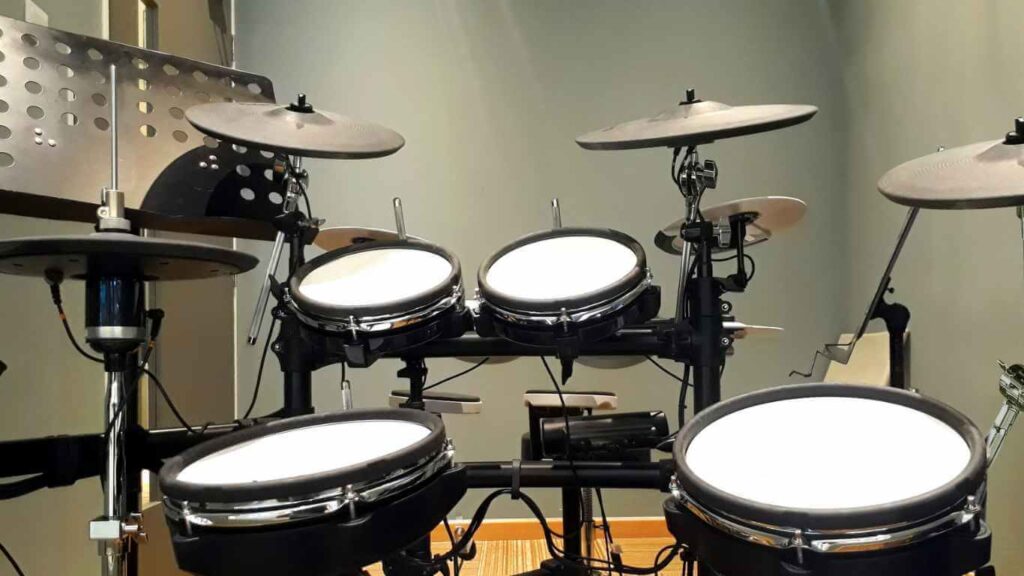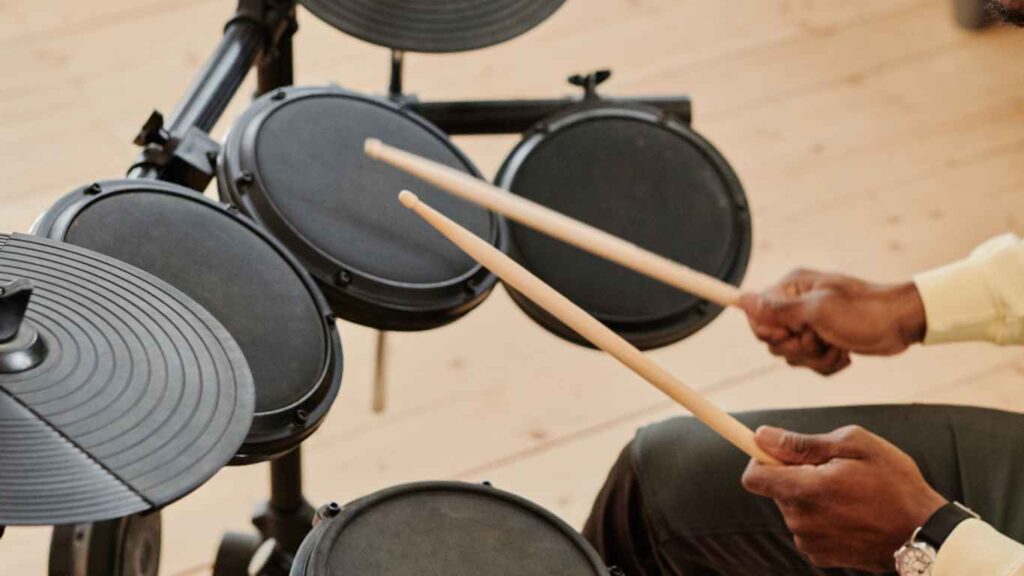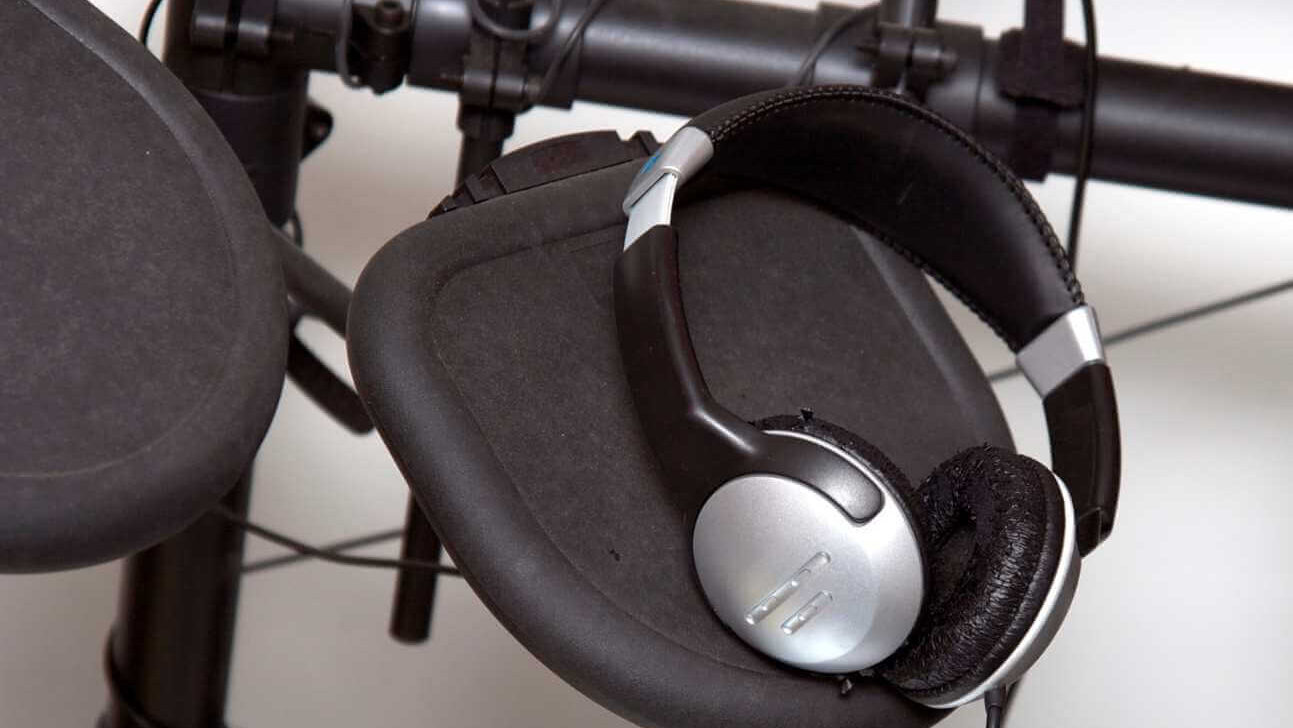Hey there, rhythm enthusiasts! It’s Ron here, your go-to guy when it comes to all things drums and percussion. Today, I’m hitting a topic that’s often the subject of much debate in our drumming circles – electronic drums mesh vs rubber. If you’re knee-deep in the quest for your ideal electronic drum feel, buckle up as we dive into this drum-tech throwdown!
Tapping into the Texture of Sound
Welcome to the heartbeat of drumming technology! I’m Ron, the drum aficionado who lives for the feel of a good rhythm under my sticks. Today’s journey is a deep dive into the sensory world of electronic drumming, specifically the touch, the bounce, and the texture that comes from two prevalent types of drum pads – the mesh heads and the rubber pads.
Drummers are tactile creatures. We crave the feedback from our instruments, the way the stick rebounds off the head, and the subtle pushback that a well-tuned drum can offer. In the transition from acoustic to electronic drums, maintaining that familiar texture of sound is paramount. It’s not just about the audible sound the drum makes, but how it feels to the touch, how it responds to every nuanced movement, and how it becomes an extension of our musical expression.
Mesh heads are the modern response to this tactile need, offering a drumming experience that can closely mimic the feel of acoustic drums. They are the darlings of the electronic drum world for many, providing that oh-so-satisfying bounce and sensitivity that can make a drummer forget they’re not sitting behind a traditional kit. On the other side of the ring, we have rubber pads – the steadfast, reliable workhorses that have carried the torch of electronic percussion from its infancy. These pads may not offer the same level of acoustic simulation as mesh heads, but they bring their own unique set of advantages to the table.
So, whether you’re about to buy your first electronic set, or looking to upgrade your current one, understanding the importance of the texture of sound and how it impacts your playing is crucial. Are you after the acoustic feel or is durability your chief concern? Maybe you’re all about that bass… or should I say, “base” price? Stick around as we navigate through the nuanced world of drumming surfaces, ensuring your next hit is as satisfying to your hands as it is to your ears.

The Feel of Mesh: Bouncing to the Beat
Ah, the feel of mesh heads – it’s akin to the gentle give of a well-tuned snare drum on an acoustic set. When you strike a mesh head, it’s not just the sound that delights your ears; it’s the physical sensation rippling through the stick into your hand, faithfully mimicking the dynamic response of traditional skins. These heads are designed for drummers who want to keep the acoustic vibe alive, even in the quietest practice session.
The magic of mesh lies in its ability to be tensioned, just like an acoustic drumhead. This means you can crank it up for a tighter, more responsive feel, or loosen it for a softer, deeper bounce. This adjustability is not just fantastic for personal preference, but it’s also crucial for building and maintaining technique. When you’re working on those intricate ghost notes or honing your double stroke roll, the rebound on a mesh head provides a level of control and feedback that is incredibly conducive to technical growth.
But it’s not all about the feel; mesh heads have an ace up their sleeve: they’re quiet. For apartment dwellers, late-night practice fiends, or anyone looking to keep the peace with family and neighbors, the muted thud of a mesh head is a godsend. And for recording or live performance with electronic kits, mesh heads can offer a more authentic velocity-sensitive response, ensuring your softest touches and your mightiest whacks are captured with all the intended nuance.
In the next section, we’ll contrast these high-tech wonders with their more traditional counterpart, rubber pads, and see how they stack up in terms of durability, cost, and the all-important feel. Stay tuned to get the lowdown on the surfaces that will set the stage for your rhythmic journey.

The Durability of Rubber: Built to Last
Rubber pads have long been the steadfast workhorse in the world of electronic drums. Their durability is practically legendary; these pads can endure thousands of strikes without showing any sign of wear and tear. For the drummer who plays hard and often, rubber offers a resilience that stands the test of time and the rigors of the road. You could take these pads on a world tour, put them through daily practice, and they’d still be ready for more.
The longevity of rubber is a significant factor to consider, especially if you’re looking to make a one-time purchase that lasts for years. While mesh heads may offer a more realistic drumming experience, they can, over time, require replacement or retightening to maintain their optimal feel. Rubber, on the other hand, needs little to no maintenance. Once set up, these pads stay consistent, ensuring a reliable practice and performance surface day in and day out.
It’s not just the toughness of rubber that’s appealing, but also its practicality. These pads are generally more resistant to the elements, making them less susceptible to changes in humidity and temperature, which can be the bane of acoustic and mesh drum heads alike. This kind of reliability can be incredibly appealing, particularly for those who live in climates that are less than drum-friendly or for schools and institutions where drums need to withstand the enthusiastic playing of countless beginners.
In the upcoming sections, we’ll delve into the various aspects that define the playing experience on electronic drums, from the nuances in their response to your playing dynamics to how these different materials can influence your playing style and learning curve. Whether you’re looking for something that will last a lifetime or provide a more authentic feel, we’ve got the details coming up to help you make the perfect choice for your percussion path.

Sound and Silence: Volume Considerations
When delving into the world of electronic drumming, volume considerations are a significant part of the equation, especially when comparing mesh heads with rubber pads. The impact of sound – or the lack thereof – can be a decisive factor for many drummers, influencing practice routines, performance dynamics, and the happiness of cohabitants and neighbors.
Mesh heads are celebrated for their low volume output. They are specifically designed to produce minimal acoustic sound while still providing a realistic stick rebound. This makes mesh heads an excellent choice for drummers living in apartments, shared houses, or any environment where noise could be a nuisance. The ability to practice at any hour without disturbing others is one of the strongest arguments for choosing mesh heads over rubber pads. This silent benefit also extends to recording scenarios where unwanted background noise needs to be minimized.
Rubber pads, on the other hand, tend to generate more acoustic noise when struck. The density of rubber as a material naturally produces a louder stick impact sound, which can be quite audible in a quiet room. While this might not be an issue in a soundproof studio or an isolated practice space, in a domestic setting, the added volume can become a problem. Some drummers mitigate this by adding noise-reduction mats or using headphones to keep the peace, but the inherent noise level is still something to bear in mind.
Furthermore, the sound generated by each type of pad also affects the player’s experience. While headphones or amplification can make the volume level irrelevant to the outside world, the drummer still requires a certain level of auditory feedback. Mesh heads can provide a more subtle and low-volume feedback that closely mimics the experience of an acoustic set, which can be comforting and familiar to those transitioning from traditional drums. Rubber pads, while louder, offer a different kind of feedback, with a more pronounced and immediate auditory cue upon each strike.
It’s also worth noting that in a live setting, electronic drums can be directly plugged into a PA system, rendering the acoustic volume of the pads somewhat moot. In such scenarios, the feel and response of the pads take precedence over their acoustic sound. However, during unplugged practice sessions or small acoustic gigs, the volume of the drum pads becomes a critical aspect of performance.
In conclusion, when contemplating the balance between sound and silence in electronic drumming, one must consider their personal environment, the needs of those around them, and their own sensory preferences. Mesh heads often win out for those who value quietness and a more authentic stick feel, while rubber pads can serve well in situations where volume is less of a constraint. Making the right choice involves assessing not just how much noise you can make, but how much you should make, ensuring harmony both in your music and your surroundings.
The Tactile Touch: Texture and Response
When it comes to the playing surface of electronic drum pads, texture plays a crucial role in the tactile experience and response during a performance. Rubber pads often present a smoother surface, which can lead to a different stick rebound compared to their mesh counterparts. This unique response can influence the drummer’s technique, as the reduced bounce may require a more deliberate and controlled stroke. However, some drummers appreciate the firmness of rubber, as it can encourage a more forceful playing style, building stamina and strength.
Mesh heads, conversely, offer a closer mimicry to the response of traditional drum skins. Their woven surface provides a degree of ‘give’ that feels more natural and forgiving, allowing for nuanced dynamics and a subtler interplay between the drumstick and the drum head. This can be particularly beneficial for those looking to translate their acoustic playing skills directly onto an electronic set without having to adjust their touch significantly.
The choice between mesh and rubber can also affect how drummers approach their ghost notes and intricate sticking patterns. With mesh heads, the bounce-back is more pronounced, which can be an advantage when executing fast and complex rhythms. For some, this can be a revelation, offering a level of expressiveness that was previously hard to achieve on electronic kits. Others may find that the extra rebound makes it difficult to control softer touches and requires an adjustment period to master.
In the following sections, we’ll dive deeper into how these different surfaces can impact your drumming journey, whether you’re practicing in the quiet of your home studio or bringing down the house on stage. We’ll discuss how they interact with different drumming techniques, the way they feel under your sticks, and how each can benefit your playing style. The aim is to provide you with a comprehensive understanding so that you can find the ideal electronic drum feel that resonates with your personal groove.
Customization and Control: Adjusting to Your Liking
Diving into the world of electronic drumming opens up a spectrum of customization options that are particularly exciting for tech-savvy percussionists. The essence of a drummer’s touch can be transformed through the adjustability of mesh heads and the programming of rubber pads, offering a level of control that acoustic kits can’t match. This adjustability is not just about volume control; it’s about the personalization of the playing experience to suit your unique style and preferences.
For those using mesh heads, the tension of the head can be finely tuned, just like tuning an acoustic drum, to get the perfect amount of rebound and response. Whether you’re looking for a tighter feel for faster double strokes or a looser surface for a deeper, more resonant hit, mesh heads give you the freedom to dial in your desired feel. This ability to tweak the tightness allows for a tailored experience, making it an ideal choice for drummers who often switch between genres and playing techniques.
Rubber pads also come with their own set of customization features, primarily through the module settings. Sensitivity, threshold, curve, and more parameters can be adjusted to ensure that each pad responds exactly as you want it to. Do you prefer a harder hit for a robust sound or a lighter touch for a softer tone? The module’s control settings allow you to shape these elements, providing a consistent response that accommodates your dynamic range and playing style.
Moreover, many electronic drum modules offer layering options, so you can assign multiple sounds to a single pad and control them through your playing dynamics. This is especially beneficial for drummers who are involved in producing music or enjoy experimenting with soundscapes. The level of customization is such that you can practically become a one-person band, with a diverse palette of sounds at your fingertips, all controllable through the nuance of your playing.
In the next sections, we’ll explore how both mesh heads and rubber pads can be tailored even further through external triggers, software, and the integration of hybrid setups, enhancing the drumming experience to unprecedented levels. Understanding the full potential of these customizations will empower you to curate your electronic drum setup not only to mimic an acoustic kit but to exceed its boundaries, pushing into new territories of musical expression.

The Noise Factor: Acoustic Footprint
When it comes to practicing on electronic drums, one of the most significant advantages is the reduction in acoustic noise—particularly crucial for drummers living in close quarters or those who need to keep the peace with family and neighbors. But it’s important to understand how different pad types can affect the volume of your playing outside of headphones.
Mesh heads are celebrated for their quieter operation, as they are designed to produce less acoustic noise when struck. The woven material significantly absorbs the impact, making it an ideal choice for late-night practice sessions or apartments where noise can be an issue. Mesh heads can mimic the dynamic range of an acoustic drum while keeping the actual sound level to a minimum. However, it’s worth noting that while quieter, they’re not completely silent. The tap of the stick on the mesh surface, the action of the kick pedal, and even the vibrations transmitted through the floor can still produce a level of sound that might be perceptible in quiet environments.
On the other hand, rubber pads tend to generate more noise. The denser material of rubber pads creates a louder stick rebound sound, which can be more noticeable to those in adjacent rooms. Even though this is still significantly quieter compared to acoustic drums, the difference in volume between mesh and rubber can be a deciding factor for those sensitive to noise. Rubber pads might require additional measures to reduce their noise level, like practice pads or isolation boards, especially in a multi-unit residence.
The ‘acoustic footprint’ of your drumming is not just a consideration for others—it can also affect your own practice. The quieter response of mesh might help you focus on the music in your headphones without being distracted by the sound of the stick hits, whereas the audible feedback from rubber pads could be a more realistic guide for some drummers who are used to acoustic kits.
As we proceed, we’ll delve into solutions and strategies for managing the acoustic footprint of both mesh heads and rubber pads. From soundproofing tips to the utilization of low-volume sticks and bass drum pedals, there are plenty of ways to ensure that your electronic drumming experience is as neighbor-friendly as it is musically satisfying. Understanding the noise level you can manage will help you make an informed decision about which type of pad will best suit your living situation and your drumming needs.
Cost and Longevity: Investing Wisely
Navigating the crossroads of cost and longevity in electronic drumming gear is crucial for both new drummers on a budget and seasoned players looking to invest wisely. The debate between mesh heads and rubber pads is not only about feel and response but also hinges on their price tag and durability over time.
Starting with mesh heads, they are often seen as the premium option and, as such, come with a higher upfront cost. This investment, however, is typically justified by their extended durability and the more realistic playing experience they provide. Mesh heads are engineered to withstand thousands of strikes, making them a long-term ally for rigorous practice. Moreover, the tension on these heads can be adjusted, which not only alters the feel and response but also extends the life of the head by evening out the wear across the surface.
Conversely, rubber pads, while generally more affordable, may reflect their price in their lifespan. The hardness of the rubber surface can be prone to wear and tear, especially in the zones that see the most contact. Over time, heavy hitters might notice that the rubber begins to degrade, which can affect the pad’s sensitivity and responsiveness. That said, advancements in materials and design have increased the longevity of high-quality rubber pads, which can now offer many years of reliable service.
It’s also important to consider the cost of replacements and repairs over the life of your drum kit. Mesh heads, while durable, can be more expensive to replace than rubber pads. However, the frequency of replacement tends to be less with mesh heads due to their resiliency. For rubber pads, even though individual pads may be cheaper, if they need to be replaced more often, the costs can add up.
In weighing cost against longevity, one must also factor in the type of drummer you are. If you’re a heavy hitter or a frequent player, investing in a higher-quality mesh head kit might save you money in the long run. For more casual players, or those who don’t mind the feel of rubber, a lower-cost setup with rubber pads might be entirely adequate and more cost-effective.
Ultimately, the decision should align with your personal circumstances. Budgeting for an electronic drum kit demands a balance between initial expense and future savings. By considering how much you’re willing to spend initially and the potential costs of maintenance, you can choose between mesh heads and rubber pads in a way that ensures a satisfying drumming experience and a wise investment over time. Keep in mind that while quality often comes at a higher price point, the longevity and enjoyment you derive from your chosen equipment are priceless components of your musical journey.
Striking a Personal Chord
Deciding between mesh heads and rubber pads ultimately comes down to personal preference, playing style, and practical considerations. Mesh heads offer an authentic feel with quiet operation, ideal for nuanced players and shared living spaces. Rubber pads are the workhorses, offering durability and consistency at a more accessible price point.
Remember, the best drumming experience is the one that feels right for you. Experiment with both, and trust your hands (and ears!) to be the judge. Whether you’re a beginner laying down the foundations or a seasoned pro refining your technique, the perfect electronic drum feel is out there waiting for you.




